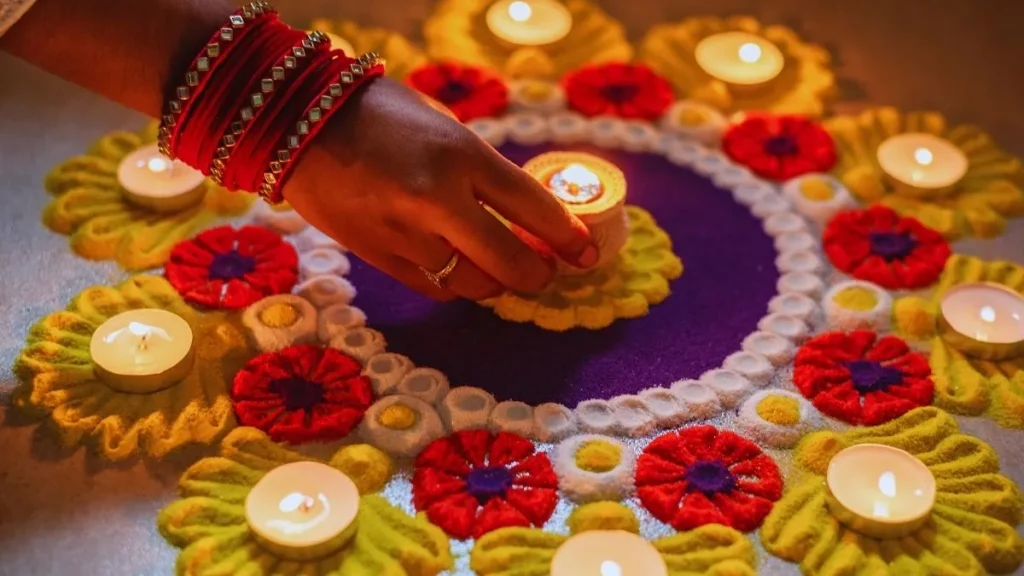Diwali, the festival of lights, is a time of joy, celebration, and tradition. One of the most cherished Diwali traditions is creating colourful and intricate rangolis at the entrance of homes, symbolising welcoming prosperity, luck, and positive energy. According to Vastu Shastra, the ancient Indian science of architecture, there are specific guidelines to follow while making rangoli to enhance its positive effects and bring harmony into the household. Following these Vastu tips can ensure that your Diwali 2024 rangoli decorations invite the best energies into your home!
1. Choose the Right Spot for Your Rangoli
According to Vastu Shastra, the placement of rangoli is crucial for attracting positive energies:
- Main Entrance: The house’s main entrance is the most auspicious place for rangoli. Vastu believes that the entrance is the gateway for energies, so placing a rangoli here helps to welcome wealth, happiness, and good luck into your home.
- Living Room or Pooja Room: According to Vastu, you can also place smaller rangolis in the living room or near the pooja (prayer) area, which are high-energy zones.
- Avoid Corners: Corners or spaces close to bathrooms and storage areas should be avoided, as, according to Vastu, these areas do not support the positive energy flow.
2. Use Auspicious Symbols in Your Rangoli
The designs and symbols used in your rangoli can significantly influence the energy it brings. Some symbols are considered highly auspicious:
- Swastika: The swastika symbol represents prosperity, good fortune, and well-being. Including a swastika design in your rangoli helps create a positive and balanced atmosphere.
- Lotus: A lotus symbolises purity, prosperity, and spiritual growth. This flower is associated with Goddess Lakshmi, making it a perfect addition to Diwali rangolis to attract wealth and abundance.
- Footprints (Paduka): Creating small footprints representing Goddess Lakshmi’s steps signifies that she is entering your home and bringing blessings and good fortune.
- OM or Shri: These sacred symbols add a spiritual element to your decoration and invoke divine energy.
3. Use Natural and Vibrant Colors
Colours play a vital role in Vastu as each colour emits a unique vibration. For Diwali, using vibrant and natural colours is highly recommended:
- Choose Bright, Festive Colors: Use shades like red, yellow, green, blue, and pink. Red and yellow are particularly auspicious for Diwali as they represent warmth, positivity, and joy.
- Natural Colors Over Artificial: For a more environmentally friendly approach, choose natural colours made from turmeric, rice powder, henna, and flower petals. According to Vastu, natural materials align better with positive energies and support harmony within the home.
- Balance the Colors: Avoid using too many dark or dull colours, as they can dampen the festival’s uplifting spirit. Try to balance warm and cool colours to create a harmonious rangoli design.
4. Light Up Your Rangoli
Diwali is about lighting up spaces and illuminating your rangoli to enhance its beauty and energy.
- Diyas (Oil Lamps): Place diyas around your rangoli, especially at the main entrance, to enhance its vibrancy and attract positive energy. Diyas symbolise the triumph of light over darkness and add a warm, welcoming glow to the rangoli.
- Candles and Tea Lights: Small candles or tea lights can also be placed around your rangoli if you prefer a modern touch. Make sure the lights are placed symmetrically; as Vastu suggests, symmetry brings harmony.
- Avoid Electric Lights Directly on Rangoli: According to Vastu, natural flames, like diyas, are more auspicious than artificial lights when illuminating your rangoli.
5. Create Rangoli Designs Facing East or North
The direction you face while making the rangoli and the orientation of the design itself can also impact the energy it attracts:
- East-Facing Rangoli: Creating rangoli facing the East direction is highly auspicious, as the East is associated with new beginnings, health, and prosperity in Vastu.
- North-Facing Rangoli: The North direction is linked with wealth and abundance. A rangoli facing North is believed to attract financial prosperity and positive business opportunities.
- Avoid South-Facing Rangoli: South-facing rangoli designs should be avoided, as the South direction in Vastu is associated with more passive energies. If you must place rangoli in the South, try to add more vibrant colours to energise the space.
6. Keep the Rangoli Design Symmetrical
In Vastu, symmetry is associated with balance, harmony, and order, which brings a peaceful and positive atmosphere to the home.
- Symmetrical Designs: Opt for symmetrical patterns, which create a sense of balance and calm. Circular, square, or mandala patterns are ideal, as they naturally form balanced designs.
- Avoid Asymmetrical or Sharp Patterns: Avoid overly sharp, jagged designs, which can create disruptive energy. Instead, choose rounded or flowing patterns to maintain a sense of tranquillity.
7. Choose the Right Time for Creating Rangoli
Timing can play a role in enhancing the spiritual effects of your rangoli:
- Morning or Evening: According to Vastu, the best times to make rangoli are early morning or just before sunset, as these times align with the natural energy flow.
- On Diwali Night: Many people choose to make their rangoli on Diwali night after sunset and during the Lakshmi Puja. This is an ideal time, as the night’s energy is believed to be more potent in welcoming Goddess Lakshmi into the home.
8. Maintain Cleanliness Around the Rangoli
Vastu strongly emphasises cleanliness, as it is essential for inviting positive energy.
- Keep the Area Tidy: Clean the area thoroughly before starting your rangoli. A clean entrance or space reflects purity and readiness to welcome divine energy.
- Avoid Stepping on Rangoli: Ensure the rangoli is placed so it won’t be accidentally stepped on. This can disrupt the energy and is considered disrespectful. Placing barriers or marking the area can help prevent accidental smudging.
9. Involve Family Members
Diwali is a festival of togetherness, and involving family members in rangoli-making enhances its joy and auspiciousness.
- Family Unity: According to Vastu, activities done together strengthen family bonds and create a positive, harmonious atmosphere. Let each family member contribute by placing colours, diyas, or flowers around the rangoli.
- Children’s Participation: Allowing children to help brings a sense of excitement and joy, which fills the home with positivity and love.
Final Thoughts
Creating a rangoli with Vastu principles enhances its aesthetic beauty and amplifies the positive energies in your home. Following these Vastu tips, you can make the most of your Diwali 2024 celebrations, bringing your family prosperity, happiness, and harmony. Let this Diwali’s rangoli not just be a work of art but also a symbol of divine blessings, welcoming peace and good fortune into your life.
Happy Diwali, and may your home be filled with light, love, and prosperity!







